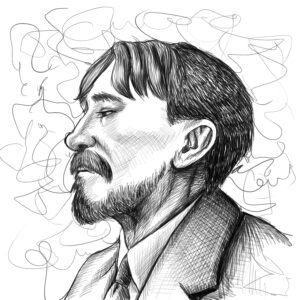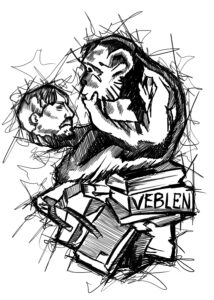 More than a century ago, American economist Thorstein Veblen described our society as a “Pecuniary Culture.” A standard dictionary might define “pecuniary” as “relating to or consisting of money” or “a current medium of exchange.” These definitions suggest that money is largely functional, transactional, or economic. Yet, Veblen’s meaning reached further. He argued that our inherent human behaviors are expressed and filtered through the socioeconomic mechanisms tied to money. Much as older cultures guided behavior through shared rituals and norms, pecuniary culture channels our “Naked Ape” impulses using the novel filters created by the fusion of those instincts with what Veblen called “the state of the industrial arts.”
More than a century ago, American economist Thorstein Veblen described our society as a “Pecuniary Culture.” A standard dictionary might define “pecuniary” as “relating to or consisting of money” or “a current medium of exchange.” These definitions suggest that money is largely functional, transactional, or economic. Yet, Veblen’s meaning reached further. He argued that our inherent human behaviors are expressed and filtered through the socioeconomic mechanisms tied to money. Much as older cultures guided behavior through shared rituals and norms, pecuniary culture channels our “Naked Ape” impulses using the novel filters created by the fusion of those instincts with what Veblen called “the state of the industrial arts.”
Today, we see pecuniary culture everywhere. Beyond physical currency, we have digital platforms, cryptocurrencies, and credit systems that reinforce the transactional nature of everyday life. On social media, for instance, conspicuous displays of wealth, designer clothing, luxury travel, or the latest tech gadgets, function much like trophies, echoing Veblen’s observations in a new, digital realm.
The Rise of the Post-Industrial Leisure Class
This pecuniary culture emerged from the Industrial Revolution and its unprecedented capacity to produce immense fortunes for what Veblen termed the “Leisure Class.” Throughout history, an elite stratum exempt from physical labor has persistently reappeared, always distinguished by one crucial attribute: freedom from the struggle for subsistence. Veblen held that this class also exudes an emulative prowess that garners widespread honor and esteem.
Veblen’s concept of a post-industrial Leisure Class arose particularly from the ownership of newly advanced industrial systems. Alongside factory-based production, the era saw the introduction of financial instruments like equities and bonds that leveraged ownership values. Initially, during the earlier phases of industrialization, “Captains of Industry” owned their enterprises and typically understood the technological heart of their operations. Over time, though, a rift opened between industrial and non-industrial activities. This paved the way for the rise of “Captains of Finance,” whose focus lay in extracting pecuniary gain from the manipulation of intangible ownership, rather than generating wealth through direct, productive labor.
We can observe parallels today in the distinction between tech founders who create tangible products or services and hedge fund managers or venture capitalists primarily engaged in the realm of financial speculation. In each case, the individuals at the top reap economic rewards that position them firmly within a modern Leisure Class.
Wealth as the New Source of Prowess, Honor, and Esteem
Over time, wealth became the dominant yardstick for status in this emerging pecuniary system, overshadowing older sources of prestige, honor, and prowess. Signaling status through consumption was no longer confined to a small elite. Rather, the entire society, shaped by human nature’s tendency to emulate, created a vast, hierarchical ranking system revolving around economic success.
In Veblen’s view, individuals do not collect wealth solely for the practical benefits it provides, emulation lies at the heart of this drive. Because wealth confers honor and “invidious distinction,” subsistence and comfort become secondary motivators. Instead, it is crucial to demonstrate financial success through “Conspicuous Consumption” and “Conspicuous Leisure.” Whether in the form of designer labels, social media travel diaries, or costly renovations, the evidence of high status must be visible to others.
This same mindset pervades modern consumer culture. Social media “influencers” often show off luxury goods or experiences to gain followers, fueling a cycle in which conspicuous displays of wealth, real or staged, function as markers of prestige. Veblen’s thesis remains relevant: the visible demonstration of monetary prowess still garners approval and sets social benchmarks for esteem.
Evolution of the Predatory-Pecuniary Culture
The growth of the predatory-pecuniary culture has been neither sudden nor accidental. Rather, it reflects a steady accumulation of “predatory aptitudes, habits, and traditions,” which develop alongside more constructive human instincts, what Veblen termed “Idle Curiosity” and “Workmanship.” The Industrial Revolution’s progress relied on a vast stock of shared knowledge that Veblen called “the common stock of knowledge.” From this pool, successive breakthroughs emerged through creative recombinations of technology and ideas, shaped by a culture’s aptitude and temperament.
Amid this technological and intellectual evolution, ownership became the bedrock of pecuniary culture. Property, from physical loot in ancient times to the intangible assets of modern finance (stocks, derivatives, cryptocurrencies, or even non-fungible tokens), has always involved emulation. Even digital tokens and NFTs can be viewed as contemporary “trophies,” displaying the owner’s ability to stake a claim in an exclusive or high-value domain.
Veblen’s distinction between “predatory” business and “matter-of-fact” industrial processes remains at the heart of modern economics. Industry, governed by physical sciences, aims at efficiency and the large-scale provision of goods and services. By contrast, business pursues pecuniary gain through transactions and speculation. As Veblen put it, “the end is pecuniary gain, the means is the disturbance of the industrial system.” This tension persists in modern high finance, where strategies such as high-frequency trading, leveraged buyouts, and market speculation may yield immense profits while creating instability for industries and workers.
Growing Irksomeness and Indignity of Labor
As a pecuniary culture matures, the notion of labor takes on an irksome character. Because labor is socially classified as “drudgery,” it becomes marked by indignity. Abstention from labor morphs into an honorific ideal, signifying decency and merit within the social order. Viewed this way, labor becomes the opposite of status, forming a stark boundary between those who must work and those who can afford to abstain.
In the modern gig economy, for instance, the precarious nature of work often highlights the distinction between “irksome” manual or service labor and white-collar or tech-oriented jobs offering flexible schedules and higher pay. This disparity reinforces a hierarchy of employment status, reflecting Veblen’s notion that the tools and implements of industry remain “beneath the dignity of the able-bodied” in societies where pecuniary norms prevail.
Canons of Pecuniary Taste
This constant emulation shapes consumer habits and the meaning of luxury. Conspicuous consumption transforms everyday spending into an avenue for attaining status and recognition. In this system, the lower strata work and save to emulate wealthier groups’ consumption patterns, though they remain limited by their productive labor and thrift. Over time, even basic virtues like industry and frugality can lose ground to the powerful allure of pecuniary signaling.
Within pecuniary culture, a “code of accredited canons of consumption and prescriptive usage” develops, revolving around expensive and sometimes wasteful goods that display a household’s economic position. An item’s “beauty” may lie more in its costliness than in its aesthetic or practical merits. The Leisure Class prizes these possessions for personal enjoyment, but they also serve as potent markers of status, both to others and to oneself. When value rests largely on cost, the line between aesthetic beauty and “pecuniary beauty” can blur, as seen in luxury brands, designer fashions, and exclusive “members-only” experiences.
Fashion, for example, cycles through trends that shift quickly, encouraging consumers to keep pace with what is newly coveted. This dynamic is evident across social strata, from a new sneaker drop that sells out within minutes online to the periodic redesign of smartphone models, each iteration slightly more advanced and more expensive than the last.
Critiques and Contemporary Relevance
Veblen’s theories have sparked ongoing debate among scholars who examine class, status, and culture. Some argue that other forms of capital matter just as much as economic wealth. For instance, sociologist Pierre Bourdieu points to “cultural capital,” emphasizing how education, language proficiency, tastes, and knowledge also confer status and distinction. Veblen himself acknowledged that human behavior is multifaceted, characterized by both the “predatory” instinct for ownership and the “productive” instincts of curiosity and workmanship.
From a historical standpoint, the shift from late 19th-century industrial capitalism to a 21st-century digital economy highlights how Veblen’s insights still resonate. The Captains of Finance now might be hedge fund managers, tech investors, or cryptocurrency “whales.” They trade intangible assets in cyberspace, sometimes disconnected from productive industry. Meanwhile, a globalized gig economy places many forms of labor at the mercy of markets that prize minimal costs for maximum returns, further illustrating the “disturbance of the industrial system” Veblen described.
Critics also note that Veblen’s theories do not directly address systemic inequalities tied to race, gender, and global hierarchies. Modern scholars broaden Veblen’s framework by examining how these social divisions interact with pecuniary culture, shaping who is allowed to rise into the Leisure Class and under what conditions. Nevertheless, his analysis of conspicuous consumption, invidious comparison, and predatory business practices remains strikingly relevant, offering a lens to interpret phenomena like influencer culture, lavish real-estate booms, NFT speculation, and beyond.
Summary
As American business enterprise shifted over time from managing physical industry to managing financial values, the industrial sector grew increasingly detached from the social fabric. Cheaper production was embraced to maximize pecuniary gain, generating earnings that sustain highly leveraged equities—whose valuations often hinge more on intangible perceptions than material outputs. Ultimately, these trends can undermine both physical industry (dependent on labor to build and maintain it) and the scientific spirit that arises from our innate curiosity and workmanship.
By weaving in contemporary examples, from social media influencer culture to advanced financial instruments, we can see how Veblen’s concepts continue to illuminate our modern reality. Ownership remains sacred, labor is often devalued, and status still hinges on the ability to display wealth for invidious comparison. While newer theories highlight additional dimensions like cultural capital or systemic inequalities, the fundamental tension Veblen identified, between the drive for pecuniary gain and the broader needs of industrial society, remains a potent framework for understanding the modern world.



